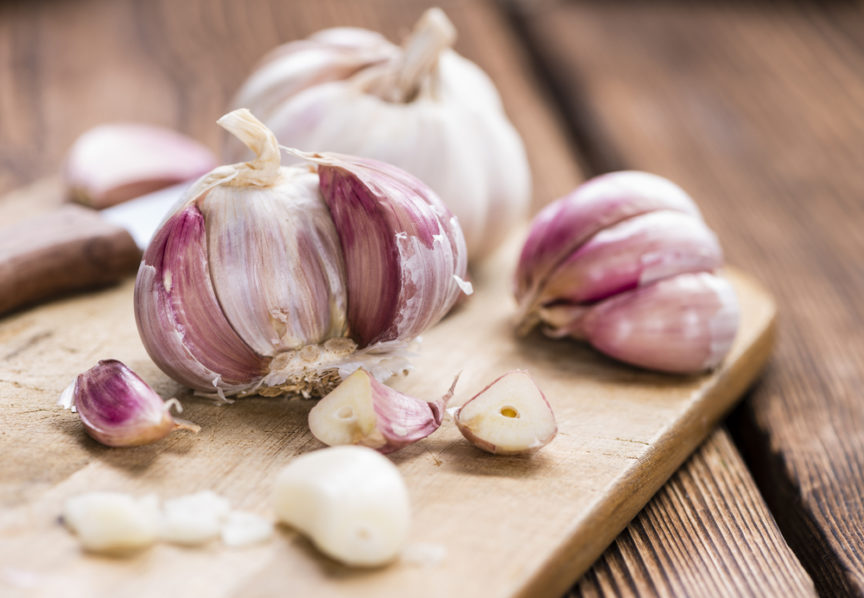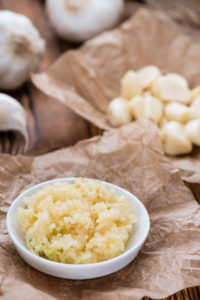Chop it, slice it, crush it or bake it whole…
For all that a mention of garlic makes many of us think of France, there’s a booming business of home-grown garlic crops here in the UK. Most of the information in this article is based on information from the Really Garlicky company based in Scotland and The Garlic Farm in the Isle of Wight.
Looking back in time and further afield, however, it is known that the builders of the pyramids were often paid in fresh garlic, in part to maintain their strength and stamina. Garlic was even found in King Tutankhamen’s tomb. Egyptian medical manuals from 1500 BC list almost two dozen treatments using garlic.There is evidence that garlic was placed in ancient Egyptian tombs as early as 5000 years ago and here are numerous references to garlic in Chinese literature as far back as 2000 BC. Chinese sacrificial lambs were spiced with garlic to make them more appealing to the gods. Garlic was praised in ancient Sanskrit writings. By 1500 BC, the cultivation of garlic had spread to virtually every civilization in Europe, Asia and North Africa.
A root herb, the plant belongs within the family of Alliaceae, in the genus, Allium; and scientifically known as Allium sativum. It is believed to be originating in the mountainous Central Asian region, from whence it spread.
About garlic
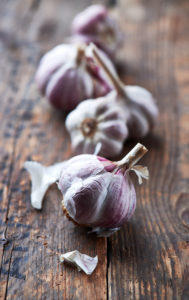 A mature garlic plant produces a bulb, sometimes called a ‘head’ of garlic, with numerous individual cloves inside the paper-like wrapper. An individual clove when planted will reproduce an entire bulb after about nine months. Some varieties of garlic also produce bulbils on top of their tall stalks (scapes). These are not true seeds, but can serve the same function. Bulbils are secondary cloves often produced in the flower cluster. There may well be over 450 identifiable strains of garlic.
A mature garlic plant produces a bulb, sometimes called a ‘head’ of garlic, with numerous individual cloves inside the paper-like wrapper. An individual clove when planted will reproduce an entire bulb after about nine months. Some varieties of garlic also produce bulbils on top of their tall stalks (scapes). These are not true seeds, but can serve the same function. Bulbils are secondary cloves often produced in the flower cluster. There may well be over 450 identifiable strains of garlic.
Just like bananas and bread, garlic should never be stored in the refrigerator! After harvest, keep bulbs in well-aerated bags or baskets. The humidity should not be too high or germination will start. Relative humidities in the 30-50% range are best. Temperatures a little below 15 degrees are ideal. In the kitchen, keep the bulbs at room temperature in a well-ventilated container. We can supply garlic keepers to suit our garlic. After harvest, bulbs will keep for several months, depending on the variety. If cloves begin to shrivel inside the wrapper, or if humidity causes sprouting, this bulb is way past its prime.
By chopping, the chemical reaction in the garlic is not activated fully so will give a milder flavour than crushing. Sliced garlic can give a good visual effect if you’re adding it to sautéed vegetables or in a salad. Lightly salting the garlic can also enhance its flavour. When garlic is cooked as whole cloves, no chemical reaction takes place to create allicin or other sulphur compounds so the flavour of the garlic will be much milder and quite different to crushed garlic. Roasting garlic whole with skins intact gives a wonderful mild, sweet, caramelised taste.
Garlic and health
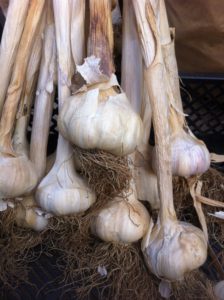 It is the sulfur compounds in garlic where the health benefits lie, it’s certainly where the immediately recognizable smell of garlic comes from.
It is the sulfur compounds in garlic where the health benefits lie, it’s certainly where the immediately recognizable smell of garlic comes from.
Since time immemorial, garlic has been recognized in almost all the cultures for its medicinal properties as well as culinary uses. This wonderful herbal plant, grown for its underground root or bulb, contains health promoting phyto-nutrient substances that have proven benefits against coronary artery diseases, infections and cancers.
Among the ailments that garlic has been proposed to alleviate to one degree or another are: acne, asthma, high blood pressure, elevated cholesterol, heart disease, diabetes, dysentery, baldness, arthritis, cancer, earache, eczema, emphysema, digestive disorders, heavy metal poisoning, infections, intestinal worms, insomnia, colds, influenza, allergies, toothache, warts and vampires. Ancient Romans were reputed to use a paste of crushed garlic to try to cure hemorrhoids. During the Black Death in Europe some doctors stuffed garlic cloves into their facemasks to help ward off the plague. Even during World War I, in the pre-antibiotic era, garlic juice was widely and effectively used as an antiseptic on the wounds of Allied soldiers.
Garlic bulbs contain organic thio-sulfinite compounds bulb which when crush or but convert into allicin through enzymatic reaction. Allicin has anti-bacterial, anti-viral, and anti-fungal qualities. Garlic is also an excellent source of minerals and vitamins essential for optimum health. The bulbs are one of the richest sources of potassium, iron, calcium, magnesium, manganese, zinc, and selenium. It contains many flavonoid anti-oxidants like carotene beta, zea-xanthin, and vitamins like vitamin-C. Vitamin C helps the body develop resistance against infectious agents and scavenge harmful, pro-inflammatory free radicals.
Garlic families
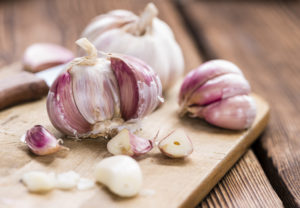 Back on home territory, in 1999 husband-and-wife team Gilli and Glen, farmers from the Cawdor hills in Scotland, recognised there was a market for premium garlic. Needing to diversify in order to safeguard their livelihoods and after two years of trials, the Really Garlicky Company was launched in 2001 when the crop was 1.5 acres. By 2010 the crop was around 30 acres, grown on Craggie Farm near Nairn in the Scottish Highlands. Gilli is a cook trained at Leiths Cookery School and their website includes many of her recipes. www.reallygarlicky.co.uk
Back on home territory, in 1999 husband-and-wife team Gilli and Glen, farmers from the Cawdor hills in Scotland, recognised there was a market for premium garlic. Needing to diversify in order to safeguard their livelihoods and after two years of trials, the Really Garlicky Company was launched in 2001 when the crop was 1.5 acres. By 2010 the crop was around 30 acres, grown on Craggie Farm near Nairn in the Scottish Highlands. Gilli is a cook trained at Leiths Cookery School and their website includes many of her recipes. www.reallygarlicky.co.uk
Down to the bottom of the country, the Edwards family has been growing garlic on the Isle of Wight for more than 40 years where they have experimenting with the many different varieties and creating many garlic infused products from chutney to beer and ice cream. Colin and Jenny (mum and dad) have even travelled to the mountains of Georgia and Kazakhstan in search of the “Mother of all garlic” and their daughter Natasha has written books on cooking with garlic and its health benefits. Another daughter, Josephine, and son Hugo run the Garlic Farm Field Kitchen at events, shows and music festivals. www.thegarlicfarm.co.uk
Nutritional information
A single garlic clove: 5 calories, 0.2 grams protein, 0.1 grams fat, 1 gram carbohydrate. Garlic cloves have amazingly high levels of vitamins and minerals. In 100g there is (in % of recommended daily allowance) 95% of vitamin B-6, 52% of vitamin C, 33% of copper, 21% of iron, 18% of calcium, 26% Selenium, and 73% of manganese.
Food features and recipes like this appear in the Desang Diabetes Magazine, our free-to-receive digital journal. We cover diabetes news, diabetes ‘kit’ and information on food suitable for maintaining good blood glucose control or a diabetic diet, including a regular Making Carbs Count column.

